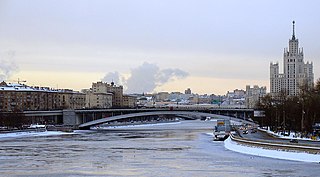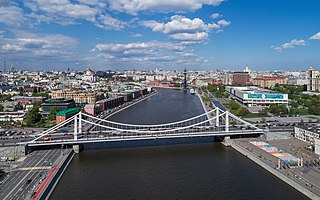
Paveletskaya is a Moscow Metro station on the Zamoskvoretskaya line, located in the Zamoskvorechye District, Central Administrative Okrug. It was opened in 1943 and was designed by S.V. Lyashchenko and E.S. Demchenko. Paveletskaya features tall white marble pillars decorated with the hammer and sickle and a high, arched ceiling. The walls are faced with white marble.
Khamovniki District is a district of Central Administrative Okrug of the federal city of Moscow, Russia. Population: 102,730 (2010 Census); 97,110 (2002 Census).

Sparrow Hills, formerly known as Lenin Hills between 1935 and 1999, is a hill on the right bank of the Moskva River and one of the highest points in Moscow, reaching a height of 80 m (260 ft) above the river level.

Bolshoy Kamenny Bridge is a steel arch bridge spanning Moskva River at the western end of the Moscow Kremlin. Its predecessor was the first permanent stone bridge in Moscow, Russia. The existing bridge was completed in 1938 by engineer Nikolai Kalmykov.

Andreyevsky Bridge name refers to a historical bridge demolished in 1998 and three existing bridges across Moskva River, located between Luzhniki and Gorky Park in Moscow.
The name Krasnoluzhsky Bridge refers to three existing bridges across Moskva River, located between Kievsky Rail Terminal and Luzhniki in Moscow.
Smolensky Metro Bridge is a steel arch bridge that spans Moskva River in Dorogomilovo District of Moscow, Russia. It is the first bridge built for the Moscow Metro in 1935–1937, designed by N.P.Polikarpov, P.K.Antonov and Yakovlev brothers. It is one of two bridges over Moskva River that are used exclusively by Metro (subway) trains, while the other Metro bridges combine road and rail.
Bolshoy Ustinsky Bridge is a steel arch bridge that spans Moskva River near the mouth of Yauza River, connecting the Boulevard Ring with Zamoskvorechye district in Moscow, Russia. It was completed in May 1938 by V.M.Vakhurkin, G.P.Golts and D.M.Sobolev.
Novospassky Bridge is a steel plate girder bridge that spans Moskva River, connecting Novospassky Monastery and Paveletsky rail terminal areas in Moscow, Russia. It was built in 1911, as a triple-span steel arch bridge. Reconstruction in 2000 replaced arches with a simpler plate girder structure. Note that the memorial plaque on the bridge spells its name Ново-Спасский, with dash, despite tradition and spelling rules.
Moscow-Riga Railroad Bridge is a concrete arch bridge that spans Moscow Canal between Tushino and Shchukino Districts in northwestern Moscow, Russia. The bridge does not have an official name and is sometimes styled as Railroad bridge over Moscow Canal. It was completed in 1936, designed by A.S.Bachelis.

Bolshoy Krasnokholmsky Bridge is a steel arch bridge that spans Moskva River in downtown Moscow, Russia, carrying Garden Ring between Tagansky District and Zamoskvorechye Districts. It was completed in 1938 by V.M.Vakhurkin, G.P.Golts and D.M.Sobolev. Its main span is the widest arch span in Moscow.

Krymsky Bridge or Crimean Bridge is a steel suspension bridge in Moscow. The bridge spans the Moskva River 1,800 metres south-west from the Kremlin and carries the Garden Ring across the river. The bridge links the Crimean Square to the north with Krymsky Val street to the south. The nearby Moscow Metro stations are Park Kultury and Oktyabrskaya.

Bolshoy Moskvoretsky Bridge is a concrete arch bridge that spans the Moskva River in Moscow, Russia, immediately east of the Moscow Kremlin. The bridge connects Red Square with Bolshaya Ordynka street in Zamoskvorechye. Built in 1936-1937, it was designed by V. S. Kirillov and Alexey Shchusev.

Saburovsky Rail Bridges are two adjacent steel bridges that span Moskva River in southern Moskvorechye-Saburovo District of Moscow, Russia. They were completed in 1924 and 1953, when Saburovo was a remote suburb of Moscow.

Borodinsky Bridge is a steel plate girder bridge that spans Moskva River, connecting Dorogomilovo District and Kievsky Rail Terminal with the centre of Moscow, Russia. The bridge was built in 1911–1912 as deck arch bridge by N.I. Oskolkov, M.I. Schekotov and Roman Klein. In 2001, the bridge was reconstructed, replacing arches and deck with a plate girder structure.

Sadovnichesky Bridge is a cоncrete pedestrian arch bridge that spans Vodootvodny Canal in historical Zamoskvorechye district of Moscow, Russia. The bridge connects Balchug island with Zamoskvorechye mainland. It was built in 1963, designed by Nina Bragina, V.A. Korchagin and K.P. Savelyev. It is Moscow's nearest adaptation of a Moon bridge.

Schluzovoy Bridge is a concrete cantilever bridge in Moscow, Russia, spanning the eastern extremity of Vodootvodny Canal and connecting right-bank embankments of Moskva River. Existing bridge was completed in 1965 by engineer Z.V. Freydina.

Preobrazhenskiy Metro Bridge is the shortest of four rail bridges in Moscow, Russia. It is located in the Eastern Administrative Okrug of the city. It spans over Yauza River and is a part of the Sokolnicheskaya Line of Moscow Metro. It connects the stations Preobrazhenskaya Ploshchad and Sokolniki.
The Luzhniki Olympic Complex is one of the biggest multifunctional sports complexes of the world, built between 1955 and 1956, located in Moscow, Russia. Formerly known as the Central Lenin Stadium, it served as the Olympic Park of the 1980 Summer Olympics.




















